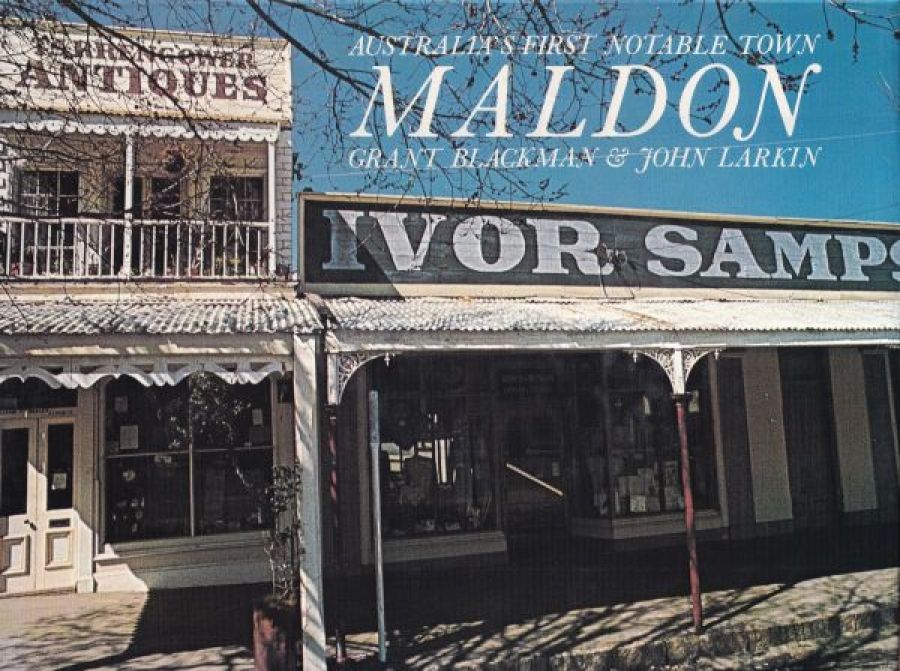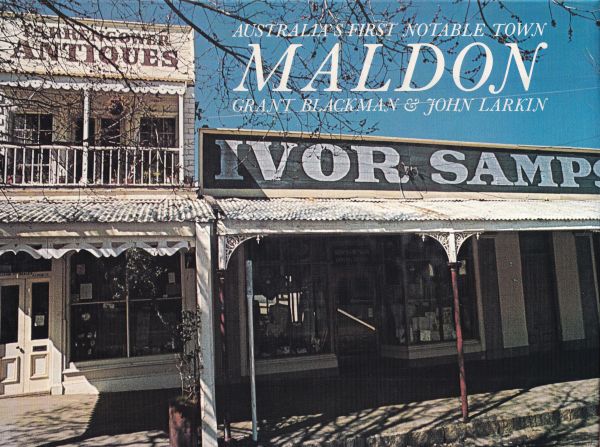
- Free Article: No
- Contents Category: Architecture
- Review Article: Yes
- Article Title: Dangers in Conversation
- Online Only: No
- Custom Highlight Text:
Five years ago prominent architectural historian, George Tibbits, rated the dearth of books available to guide people’s appreciation of their historical environment as one of the major brakes on the conservation movement in Victoria. Since then a growing number of excellent publications have attempted to redress this weakness, the latest being Grant Blackman and John Larkin’s Maldon. It follows closely on the heels of Burchett’s work on East Melbourne and has a similar format and high quality of production. Blackman’s photographs in black and white and color beautifully capture the town’s flavor and are at their best with the more intimate details of verandah variances, padlocked intimate doors, details and of cemetery headstones. Some of the more panoramic plates might have been more sharply reproduced and it is unfortunate that one or two of the captions are repetitive. Well-chosen historical photographs are interspersed to complement the modern views. The Gill sketches do not portray Maldon itself and will be familiar to readers other goldfield histories. The four David Drape paintings, on the other hand are of early Maldon scenes and one regrets that they were not reproduced in colour.
- Book 1 Title: Australia’s First Notable Town, Maldon
- Book 1 Biblio: 1978, 144 p. illus., $14.95
- Book 1 Cover Small (400 x 600):

- Book 1 Cover (800 x 1200):

The text itself covers the main features of Maldon’s evolution and has the attraction of allowing past and present residents to speak on the town’s behalf: thus Jonathon Moon describes the town of the 1860s; the early 1880s come alive through the words of Henry Handel Richardson, whose early life was spent in four areas that have become highpoints of Victoria’s historic environment - South Fitzroy, Chiltern, Koroit, and Maldon; and the memories of several of Maldon’s old residents evoke the more recent past, especially the depression years of the 1930s. The final brief chapter deals with the National Trust’s initiative in declaring Maldon ‘a notable town’ – the first and perhaps last town to receive such a nomination Australia. The book suggests overwhelming acceptance of conservation in Maldon and no mention is made of just how close the conservation plans came to failing in the early 1970s largely due to the insensitivity of the planners and the penny pinching of their government employers. While outsiders loved the town as a relic from Victoria’s past, the rigid conservation measures being implemented were of little tangible benefit to many of the traditional residents who would have preferred new shop fronts, modern motels and cement curbing along its streets, the conventional signs of a town’s progress.
Fortunately (for the conversationalists, a least) the Maldon Shire Council stopped short of throwing the whole scheme out in 1973 and the project survived to become enacted planning scheme in 1978. Fortunately, too, financial assistance to property owners is now flowing although it had to wait until 1977-78 and is still inadequate to fully compensate the large· proportion of aged residents in the town for the externally imposed development and maintenance restrictions.
Unfortunately the story of Maldon’s early clumsy management has spread over the surrounding countryside with negative effects. For example, the landowners in one nearby locality reacted with extreme hostility and actual vandalism as a result of the interest shown by the Australian Heritage Commission last year in their area’s nineteenth-century rural buildings and farm environment. Although the AHC is a relatively toothless tiger, quite unable to impose conservation restrictions, these residents’ only experience with conservation had been in Maldon and they resisted what they saw as outside interference their property rights.
Blackman and Larkins’ book is not the place to write an account of the conservation scheme’s shaky start. Their aim is to create awareness of the positive benefits to society of conserving the town – and this they do well. But it is to be hoped that another author will rise to the occasion and elaborate on this most recent past for the message to be learnt from the Maldon experience by planners, architects and government officials, and may mean the difference between success and failure for many other conservation projects about the country.


Comments powered by CComment